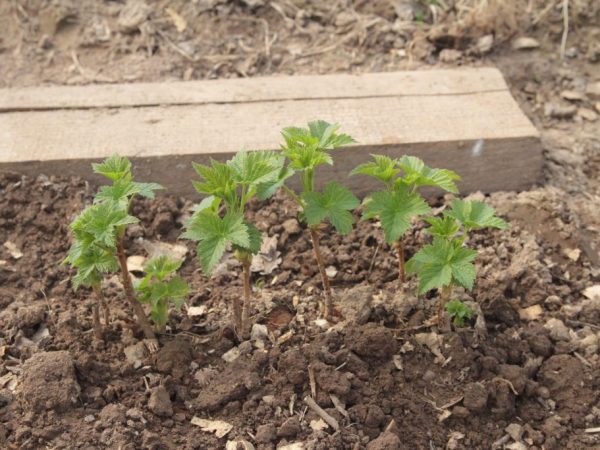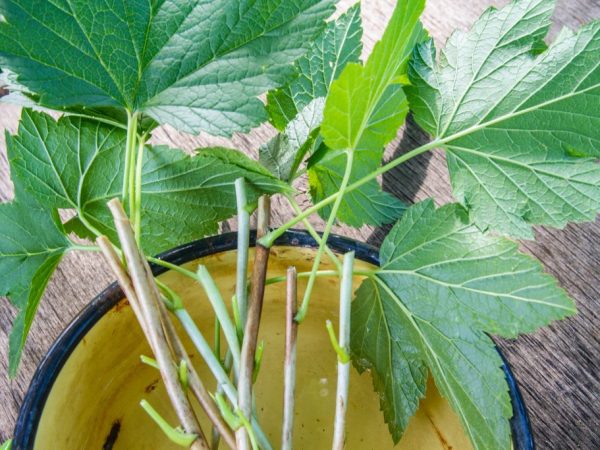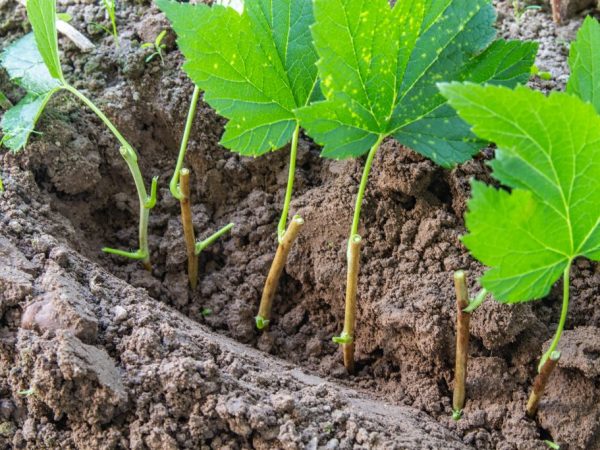Propagation of currants by cuttings - rules and recommendations
Many are engaged in self-cultivation of new seedlings - the result is almost always positive. They grow quickly and give a good harvest after a few years. Consider how to propagate currants by cuttings, and what kind of care it needs in the fall.

Propagation of currants by cuttings - rules and recommendations
Rules for harvesting cuttings
Any varieties of currants are allowed to be cut - white, red and black. The best time for breeding will be mid-October.
You can prepare cuttings in several stages:
- On a healthy bush, lignified annuals are chosen, cut off with a sharp and sterile pruning shears. It is important that they are free of cracks, breaks and signs of disease. The optimal workpiece diameter is 0.7-0.8 cm.
- The cut shoots are divided into segments 20-25 cm long. For this, a well-sharpened knife is used, since the pruner can damage the wood, which will negatively affect the survival rate.
- The upper part is cut at a right angle, and the lower one - 50-55 °.
Pruning is not recommended for propagation as it will not take root.
If the planting material needs to be transported, it is wrapped in a damp cloth, wrapped with polyethylene on top to prevent dehydration.
Advantages and disadvantages
Autumn cuttings of currants have several advantages:
- it is possible to get an unlimited amount of planting material from one plant;
- young plants will be resistant to adverse environmental influences;
- the planting of a home-grown daughter bush is carried out at different periods - in spring, summer or autumn;
- breeding technology is much simpler than seed-assisted cultivation.
In autumn, sap flow is not so active, therefore, the seedlings have increased frost resistance and do not freeze over the winter. A slight loss of moisture contributes to the intensive growth of the root system in warm weather.
The only drawback of cuttings at this time of the year is unstable weather conditions, especially in risky farming zones. Therefore, there is no 100% guarantee of the survival rate of such planting material.
Rooting methods
In order for the rooting of cuttings to be successful, they need to be lowered for 12 hours in Kornevin or another stimulant for root formation.
If you plan to grow seedlings at home, and not in the open field, you must prepare a suitable container in advance.
Many people use halves of 1.5 liter plastic bottles. Several holes are made at the bottom to drain excess moisture and ensure good air exchange.
In the open field
Usually this method is called green cuttings, it is carried out in the summer.
On a bush from 5 years old, annual shoots are chosen from the top of the crown with a length of 15-20 cm.It is important that each of them has 2-3 living kidneys.
You can root the material in the open field, over the summer it will have time to take root, put down roots and get stronger. It is necessary to plant in rows in an upright position according to the scheme - 20x10 cm.The depth of planting of green shoots is 5-7 cm.

Before planting, the cuttings must be held in a root solution.
For everything to go well, choose a sunny place with light shading. The soil is flavored with coarse sand (2 buckets), last year's manure (10 kg) and wood ash (3 kg) per 1 m².
In the first 5 days, watered daily, in extreme heat - up to three times a day. After germination of the roots, when the stems release leaves, moistening is carried out as needed.
In the substrate
You can root black, red or white currants in a nutritious substrate of coarse sand and leaf humus. They are mixed in equal proportions.
In addition to the soil composition, ready-made mineral fertilizers are added, which are sold in any gardening store. Take the amount according to the instructions on the package.
The cuttings must be planted to a depth of 2 cm. The soil is sprinkled on top with a thin layer of organic matter (compost or rotted manure). These components will warm the soil mixture to speed up the rooting of the shoots.
The cultivation of new currant seedlings is carried out in greenhouse conditions, therefore, the plantings are watered with warm water, covered with a film or transparent container, thus creating the necessary microclimate.
Condensation should form on the walls of the container or plastic bottles, providing additional moisture to the earth. If this does not happen, the plantings are periodically moistened with a spray bottle.
The optimal conditions for keeping are regular irrigation as the top layer of the soil dries out, good diffused light, humidity at the level of 65-70%. At least every other day, the seedlings should be ventilated to avoid the appearance of mold.
As soon as new buds appear on them, the shelter is removed, they continue to look after until they release several leaves. Only after that, the currants are allowed to be planted in an open area.
In water
This is the easiest way to propagate black, red or white currants. Cuttings cut and prepared in the fall according to the method described above are placed in a liter jar of water, 3-4 pieces each, so that only the two lower buds are covered.
After about 10 days, tubercles will appear below, from which roots will grow in the future.
Shoots are moved to a bright place where there is no scorching sun rays. The water is changed periodically to avoid mold. Two weeks later, strong root lobes form on the branches, buds swell and foliage blooms.
The buds that have appeared must be removed, since they take all the strength and energy from the plant for further development.
Young seedlings are planted in the spring - at the end of April or at the beginning of May. Before planting, the lower part is dipped for several hours in one of the root growth stimulants - Epin, Kornevin or Heteroauxin.
Landing in the garden
If you managed to successfully root the cuttings at home, then their further cultivation will be successful.
- A sunny area with little shading is selected - under trees, tall shrubs, along the fence or walls of the house. It is important that the site is protected from the winds.
- It is cleaned of carrion, last year's vegetation and weeds, sprinkled with mineral fertilizers (100 g of superphosphate and 80 g of potassium sulfate), humus (10 kg) and coarse sand (2 buckets) per 1 m².
- Then they carry out digging, leveling and watering.
The best time for planting is mid-spring, when the soil warms up to a temperature of 10-15 ° C.

A sunny place is suitable for planting.
It is necessary to plant cuttings, if there are a lot of them, at a certain distance, otherwise there will be competition for moisture, space and nutrients. The optimal layout is 15x30 cm.
Piping holes in size in accordance with the dimensions of the plant root system. You need to plant at an angle of 40 ° C. The roots are sprinkled with garden soil, compacted around the stem, watered - 5 liters per bush, then mulched with a 4-5 cm layer of humus.
Basic care
After planting, the seedlings need regular and competent care so that they quickly take root and grow.
2-3 weeks plantings require shelter from the sun, otherwise they will dry out and die. At lunchtime, they are covered with burlap or agrofibre.
Watering
Should be moderate, but frequent - in the first three weeks every other day. Moisture will help the roots to take root in the ground faster and stimulate the build-up of green mass. 5 liters of water are poured under one seedling.
After a month, moisten as the soil dries to a depth of 5-6 cm. It is important to take into account the amount of seasonal precipitation in order to avoid waterlogging and rotting of currants.
The next day after watering, the soil is loosened, sprouted weeds are removed, and mulch from peat or last year's manure is introduced into the near-trunk zone.
Fertilizer
A month after planting, the seedlings begin to feed with a complex composition of nitrogen, phosphorus and potassium. 1 tsp the substances are diluted in 5 liters of water. The interval between dressings is 4 weeks.
Three meals will be required per season. By autumn, feeding is stopped, so the plants will stop further growth and development.
Preparing for winter
To avoid freezing, young seedlings are sprinkled with peat on the eve of autumn frosts.
The above-ground part can be wrapped in burlap, and with the arrival of spring, when the above-ground temperature stabilizes, the insulating material is removed.
Prevention of diseases and pests
Young seedlings grown from cuttings have weak immunity, so they need preventive treatment.
In early spring (at the end of March or early April), in summer (in the second half of July) and in autumn (in the last decade of September), they are sprayed with fungicides and insecticides.
Additionally, the soil under the bushes is irrigated, in which pathogens and larvae of various insects can start.
Other breeding methods
Layers
You can dilute currants with layering. Autumn is the best time for this procedure. Approximate terms - 3-4 weeks before the first frost.
- On a healthy bush from five years old, choose the longest and strongest branch of the current year.
- A trench 3-4 cm deep is dug next to it.
- The bottom is sprinkled with a nutrient mixture of coarse sand, humus (1: 1).
- The twig is freed from buds and leaves, deepened in a horizontal position, fixed with brackets, sprinkled with earth.
- On the eve of stable cold weather, mulch with peat to prevent freezing.
- In the spring, as soon as the snow thaws, sap flow begins, the layers are dug out, carefully separated from the mother bush, and divided into several segments. Each part should have 2-3 roots and at least one kidney.
- Delenki need to be planted in a permanent place in the garden in the same way as rooted cuttings.
By dividing the bush
This method is well suited if the bush needs to be rejuvenated after 10-15 years of cultivation. It allows you to get strong seedlings with all the varietal characteristics of the bush, which the next year after planting can give a decent harvest of berries.
This procedure is carried out in the fall - at the beginning of September or in the spring until the swelling of the vegetative buds.
- The currants are watered abundantly, the next day they are dug in and carefully removed together with an earthen lump.
- Shake off the soil, wash the roots under water.
- Divide into several parts so that each has 2-3 shoots and 3-4 roots.
- To avoid infection, the injured areas are irrigated with a solution of copper sulfate.
- After drying, the delenki are seated in a permanent place in the garden, maintaining a distance between them - 50 cm, in a row - 40 cm.
Helpful hints
If you decide to carry out the propagation of currants in the fall, you need to take into account several important tips that will help you successfully carry out this process.
- Mature bushes undergo an annual spring shearing, so you should not injure the plant once again, but it is better to take pruning after this procedure.
- When taking material, the tallest shoots should be preferred, since the longer they are, the more they contain the nutrients necessary for growth and development.
- If autumn is dry and hot, it is better to harvest cuttings in the evening or wait for wet and rainy weather. The planting material saturated with moisture has a high survival rate.
- It is important not only to propagate this culture correctly and on time, but also to provide it with proper care after transplanting to the site, otherwise your labors will be useless.

